relay YAMAHA WR 250F 2007 Manuale de Empleo (in Spanish)
[x] Cancel search | Manufacturer: YAMAHA, Model Year: 2007, Model line: WR 250F, Model: YAMAHA WR 250F 2007Pages: 912, tamaño PDF: 23.95 MB
Page 800 of 912
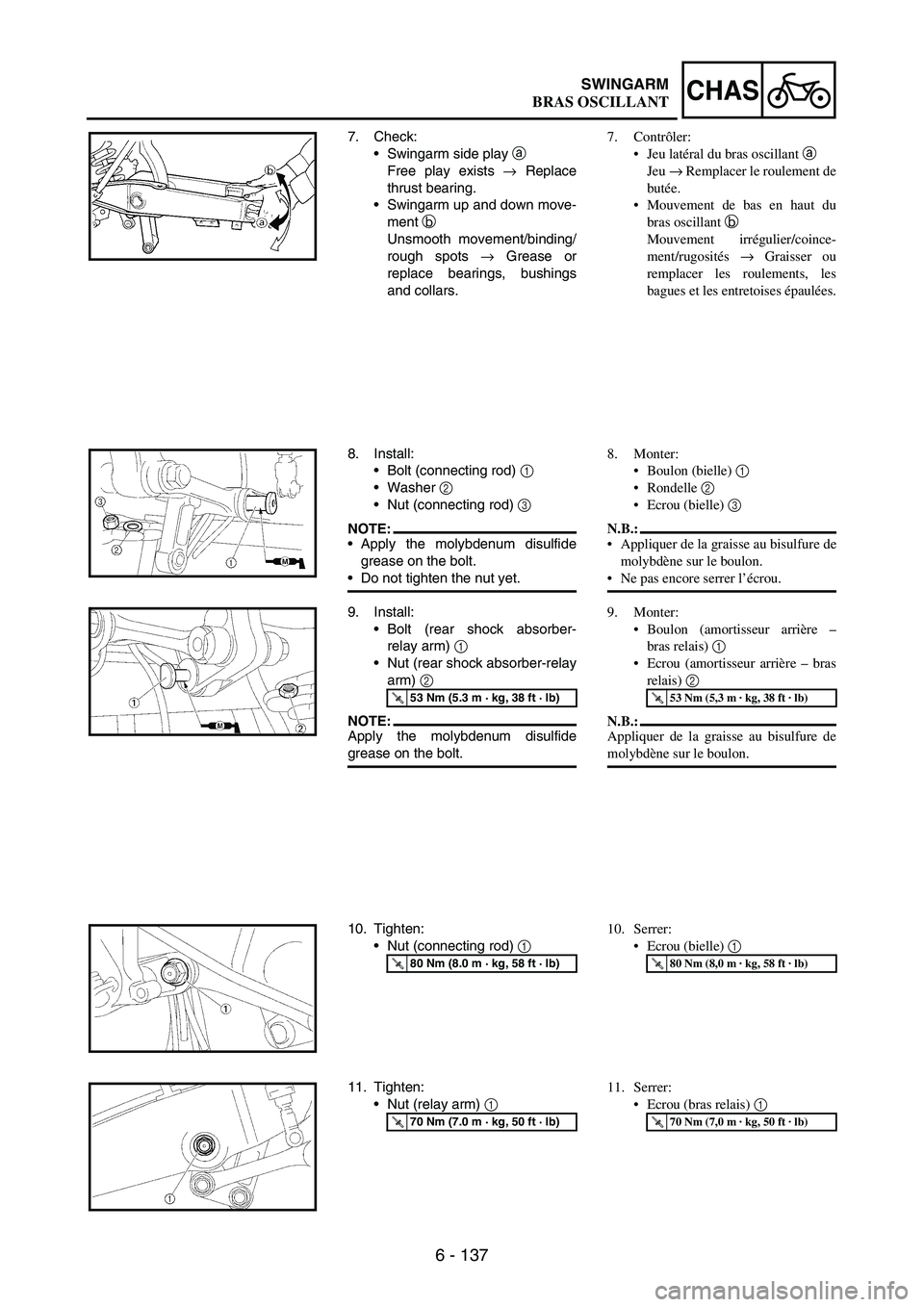
6 - 137
CHASSWINGARM
7. Check:
•Swingarm side play
a
Free play exists
→ Replace
thrust bearing.
•Swingarm up and down move-
ment
b
Unsmooth movement/binding/
rough spots
→ Grease or
replace bearings, bushings
and collars.
8. Install:
•Bolt (connecting rod)
1
•Washer
2
•Nut (connecting rod)
3
NOTE:•Apply the molybdenum disulfide
grease on the bolt.
•Do not tighten the nut yet.
9. Install:
•Bolt (rear shock absorber-
relay arm)
1
•Nut (rear shock absorber-relay
arm)
2
NOTE:Apply the molybdenum disulfide
grease on the bolt.
T R..53 Nm (5.3 m · kg, 38 ft · lb)
10. Tighten:
•Nut (connecting rod)
1
T R..80 Nm (8.0 m · kg, 58 ft · lb)
11. Tighten:
•Nut (relay arm)
1
T R..70 Nm (7.0 m · kg, 50 ft · lb)
7. Contrôler:
Jeu latéral du bras oscillant a
Jeu → Remplacer le roulement de
butée.
Mouvement de bas en haut du
bras oscillant b
Mouvement irrégulier/coince-
ment/rugosités → Graisser ou
remplacer les roulements, les
bagues et les entretoises épaulées.
8. Monter:
Boulon (bielle) 1
Rondelle 2
Ecrou (bielle) 3
N.B.:
Appliquer de la graisse au bisulfure de
molybdène sur le boulon.
Ne pas encore serrer l’écrou.
9. Monter:
Boulon (amortisseur arrière –
bras relais) 1
Ecrou (amortisseur arrière – bras
relais) 2
N.B.:
Appliquer de la graisse au bisulfure de
molybdène sur le boulon.
T R..53 Nm (5,3 m · kg, 38 ft · lb)
10. Serrer:
Ecrou (bielle) 1
T R..80 Nm (8,0 m · kg, 58 ft · lb)
11. Serrer:
Ecrou (bras relais) 1
T R..70 Nm (7,0 m · kg, 50 ft · lb)
BRAS OSCILLANT
Page 804 of 912
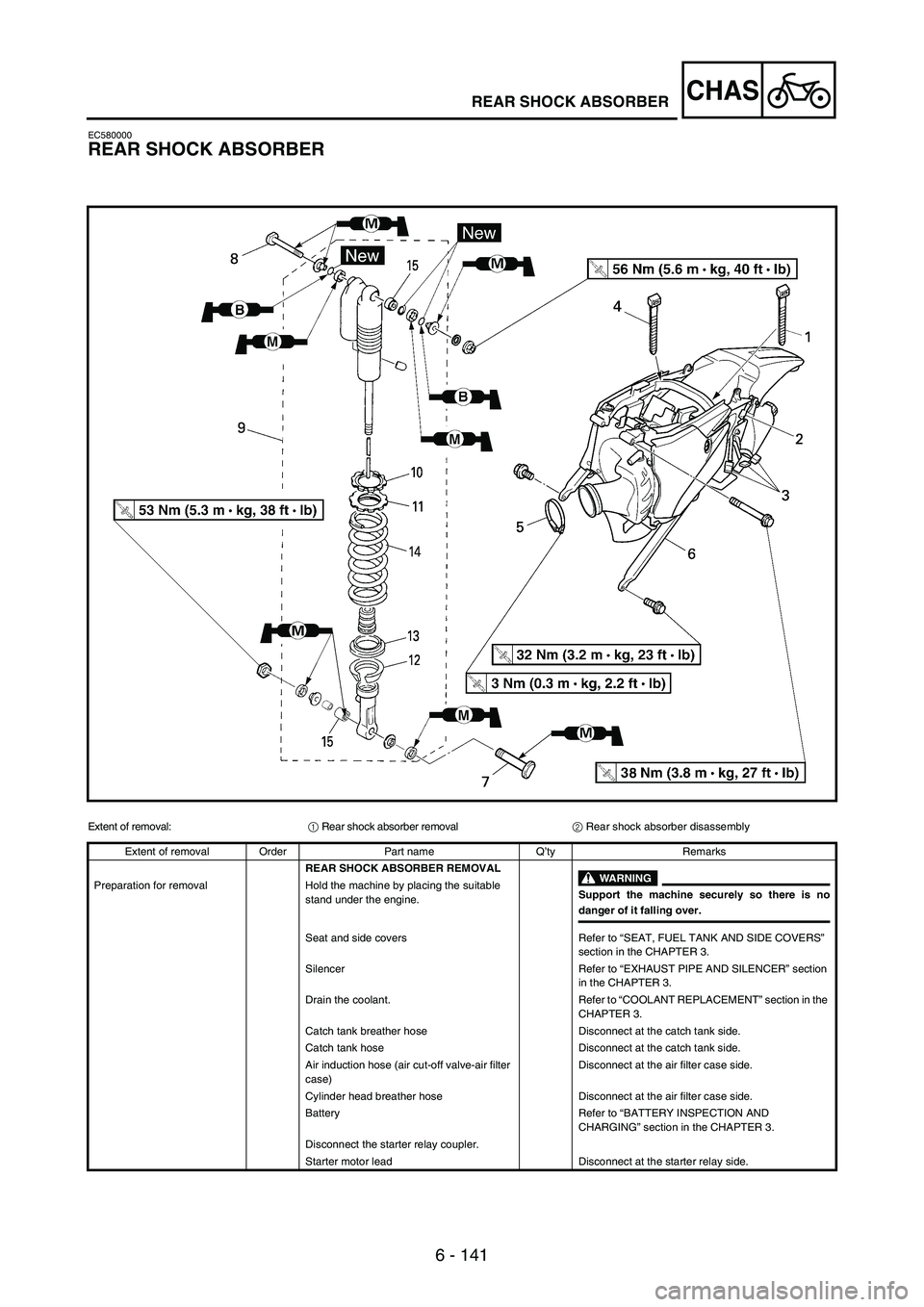
6 - 141
CHASREAR SHOCK ABSORBER
EC580000
REAR SHOCK ABSORBER
Extent of removal:
1 Rear shock absorber removal
2 Rear shock absorber disassembly
Extent of removal Order Part name Q’ty Remarks
REAR SHOCK ABSORBER REMOVAL
WARNING
Support the machine securely so there is nodanger of it falling over. Preparation for removal Hold the machine by placing the suitable
stand under the engine.
Seat and side covers Refer to “SEAT, FUEL TANK AND SIDE COVERS”
section in the CHAPTER 3.
Silencer Refer to “EXHAUST PIPE AND SILENCER” section
in the CHAPTER 3.
Drain the coolant. Refer to “COOLANT REPLACEMENT” section in the
CHAPTER 3.
Catch tank breather hose Disconnect at the catch tank side.
Catch tank hose Disconnect at the catch tank side.
Air induction hose (air cut-off valve-air filter
case)Disconnect at the air filter case side.
Cylinder head breather hose Disconnect at the air filter case side.
Battery Refer to “BATTERY INSPECTION AND
CHARGING” section in the CHAPTER 3.
Disconnect the starter relay coupler.
Starter motor lead Disconnect at the starter relay side.
Page 808 of 912
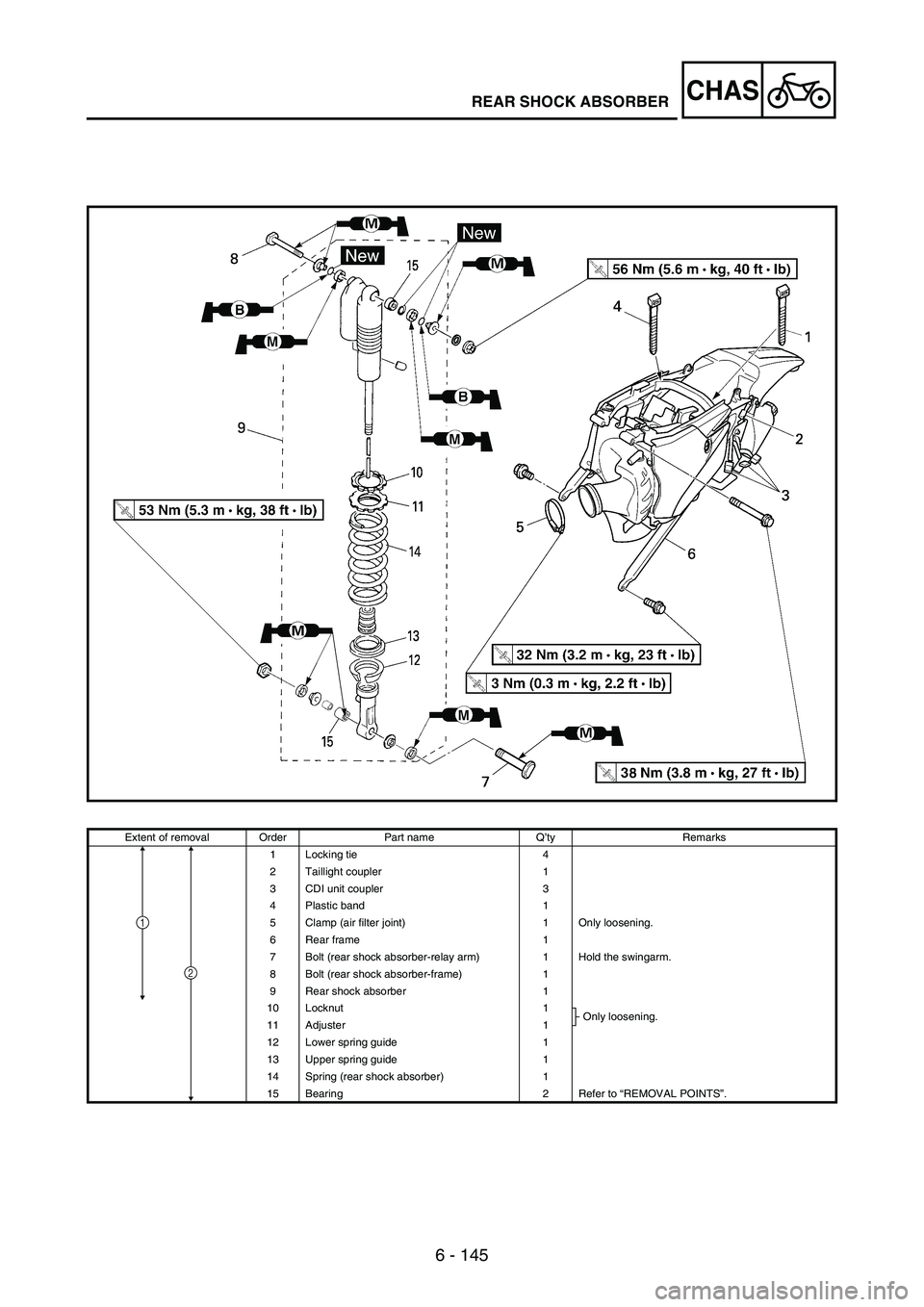
6 - 145
CHASREAR SHOCK ABSORBER
Extent of removal Order Part name Q’ty Remarks
1 Locking tie 4
2 Taillight coupler 1
3 CDI unit coupler 3
4 Plastic band 1
5 Clamp (air filter joint) 1 Only loosening.
6 Rear frame 1
7 Bolt (rear shock absorber-relay arm) 1 Hold the swingarm.
8 Bolt (rear shock absorber-frame) 1
9 Rear shock absorber 1
10 Locknut 1
Only loosening.
11 Adjuster 1
12 Lower spring guide 1
13 Upper spring guide 1
14 Spring (rear shock absorber) 1
15 Bearing 2 Refer to “REMOVAL POINTS”.
1
2
Page 820 of 912
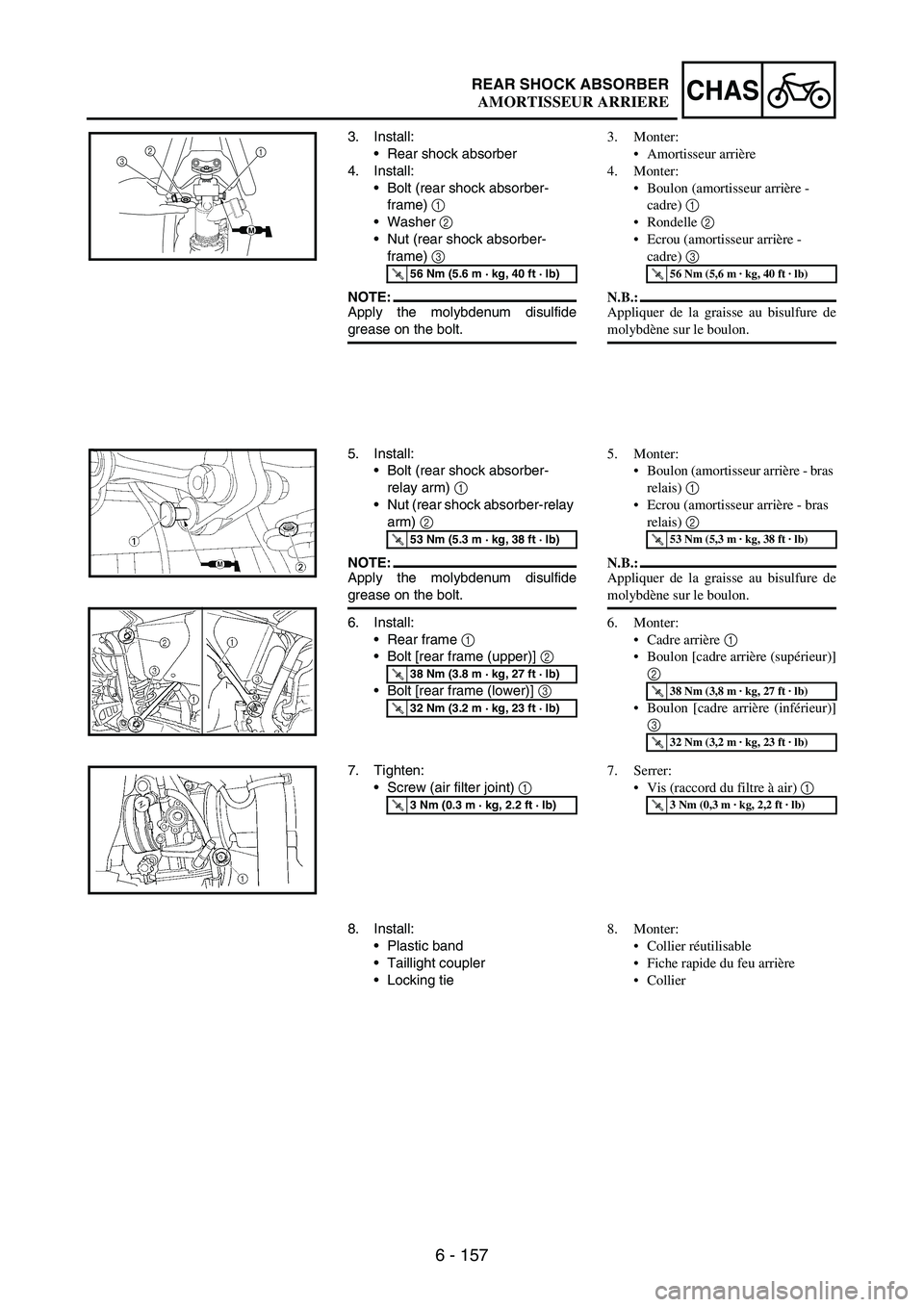
6 - 157
CHASREAR SHOCK ABSORBER
3. Install:
•Rear shock absorber
4. Install:
•Bolt (rear shock absorber-
frame)
1
•Washer
2
•Nut (rear shock absorber-
frame)
3
NOTE:Apply the molybdenum disulfide
grease on the bolt.
T R..56 Nm (5.6 m · kg, 40 ft · lb)
1 2
3
M
5. Install:
•Bolt (rear shock absorber-
relay arm)
1
•Nut (rear shock absorber-relay
arm)
2
NOTE:Apply the molybdenum disulfide
grease on the bolt.
6. Install:
•Rear frame
1
•Bolt [rear frame (upper)]
2
•Bolt [rear frame (lower)]
3
T R..53 Nm (5.3 m · kg, 38 ft · lb)
T R..38 Nm (3.8 m · kg, 27 ft · lb)
T R..32 Nm (3.2 m · kg, 23 ft · lb)
7. Tighten:
•Screw (air filter joint)
1
T R..3 Nm (0.3 m · kg, 2.2 ft · lb)
8. Install:
•Plastic band
•Taillight coupler
•Locking tie3. Monter:
Amortisseur arrière
4. Monter:
Boulon (amortisseur arrière -
cadre) 1
Rondelle 2
Ecrou (amortisseur arrière -
cadre) 3
N.B.:
Appliquer de la graisse au bisulfure de
molybdène sur le boulon.
T R..56 Nm (5,6 m · kg, 40 ft · lb)
5. Monter:
Boulon (amortisseur arrière - bras
relais) 1
Ecrou (amortisseur arrière - bras
relais) 2
N.B.:
Appliquer de la graisse au bisulfure de
molybdène sur le boulon.
6. Monter:
Cadre arrière 1
Boulon [cadre arrière (supérieur)]
2
Boulon [cadre arrière (inférieur)]
3
T R..53 Nm (5,3 m · kg, 38 ft · lb)
T R..38 Nm (3,8 m · kg, 27 ft · lb)
T R..32 Nm (3,2 m · kg, 23 ft · lb)
7. Serrer:
Vis (raccord du filtre à air) 1
T R..3 Nm (0,3 m · kg, 2,2 ft · lb)
8. Monter:
Collier réutilisable
Fiche rapide du feu arrière
Collier
AMORTISSEUR ARRIERE
Page 822 of 912
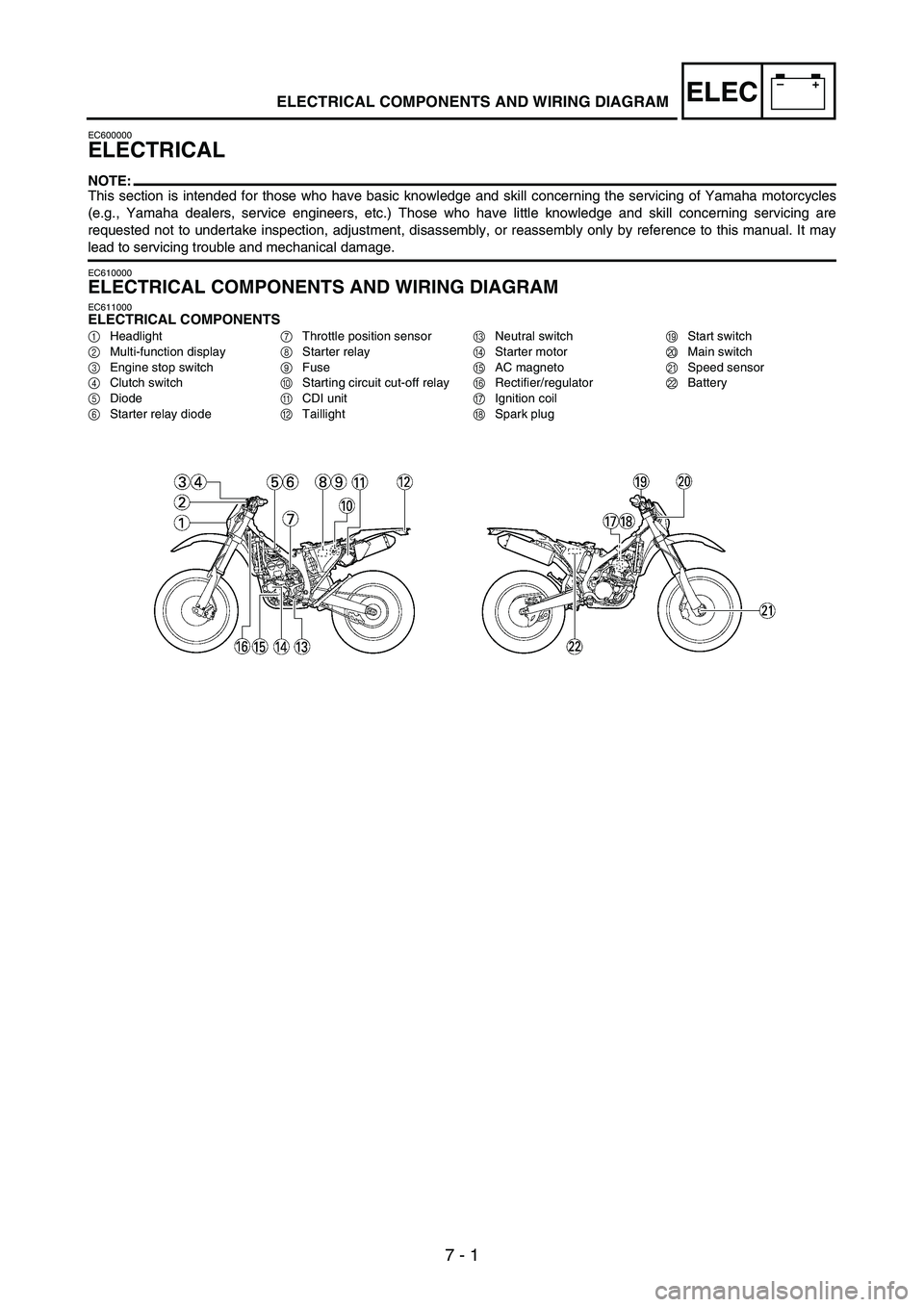
7 - 1
–+ELECELECTRICAL COMPONENTS AND WIRING DIAGRAM
EC600000
ELECTRICAL
NOTE:This section is intended for those who have basic knowledge and skill concerning the servicing of Yamaha motorcycles
(e.g., Yamaha dealers, service engineers, etc.) Those who have little knowledge and skill concerning servicing are
requested not to undertake inspection, adjustment, disassembly, or reassembly only by reference to this manual. It may
lead to servicing trouble and mechanical damage.
EC610000
ELECTRICAL COMPONENTS AND WIRING DIAGRAM
EC611000ELECTRICAL COMPONENTS
1Headlight
2Multi-function display
3Engine stop switch
4Clutch switch
5Diode
6Starter relay diode7Throttle position sensor
8Starter relay
9Fuse
0Starting circuit cut-off relay
ACDI unit
BTaillightCNeutral switch
DStarter motor
EAC magneto
FRectifier/regulator
GIgnition coil
HSpark plugIStart switch
JMain switch
KSpeed sensor
LBattery
Page 824 of 912
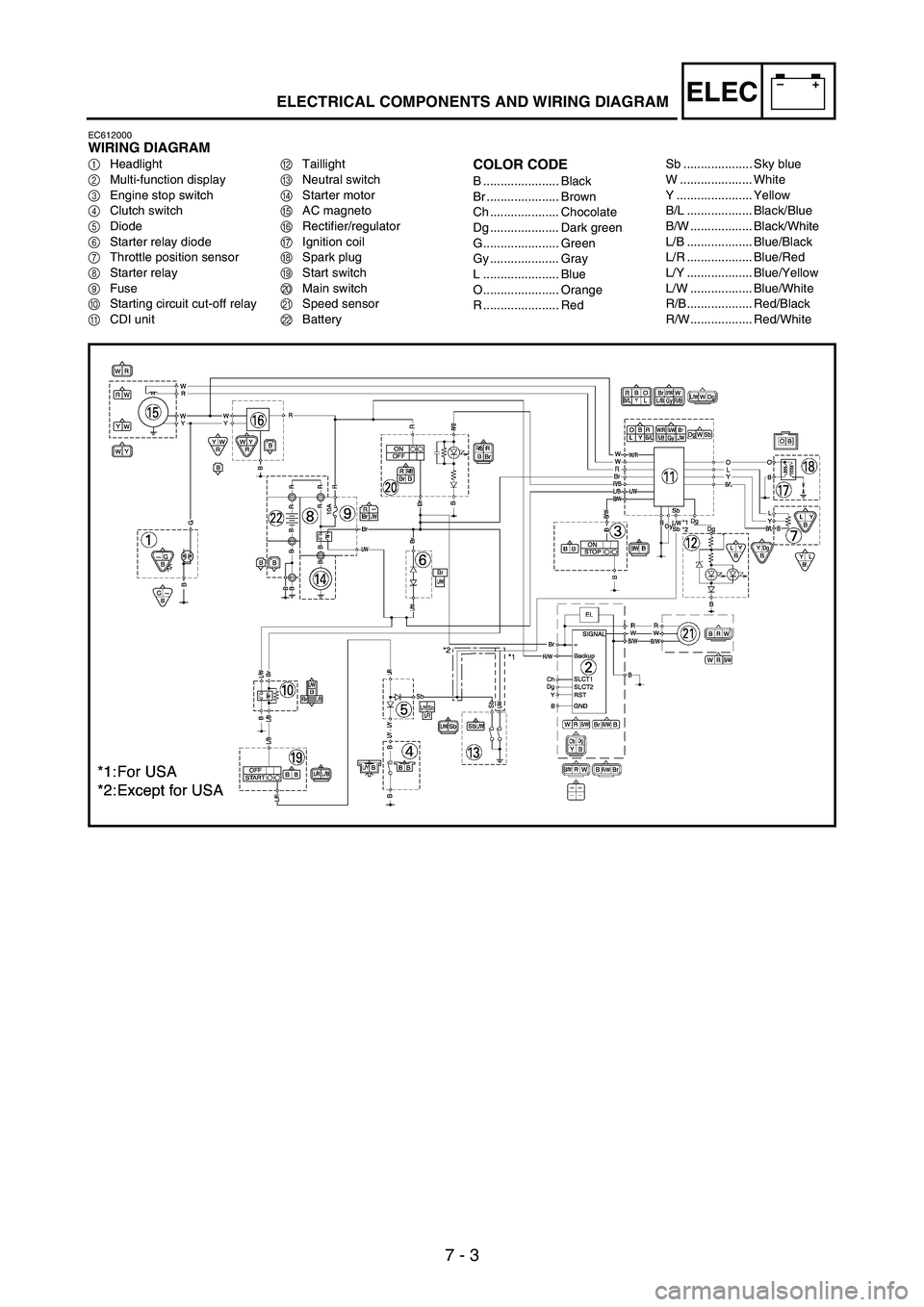
7 - 3
–+ELECELECTRICAL COMPONENTS AND WIRING DIAGRAM
EC612000WIRING DIAGRAM
1Headlight
2Multi-function display
3Engine stop switch
4Clutch switch
5Diode
6Starter relay diode
7Throttle position sensor
8Starter relay
9Fuse
0Starting circuit cut-off relay
ACDI unitBTaillight
CNeutral switch
DStarter motor
EAC magneto
FRectifier/regulator
GIgnition coil
HSpark plug
IStart switch
JMain switch
KSpeed sensor
LBatteryCOLOR CODE
B ...................... Black
Br ..................... Brown
Ch .................... Chocolate
Dg .................... Dark green
G...................... Green
Gy .................... Gray
L ...................... Blue
O...................... Orange
R ...................... RedSb .................... Sky blue
W ..................... White
Y ...................... Yellow
B/L ................... Black/Blue
B/W .................. Black/White
L/B ................... Blue/Black
L/R ................... Blue/Red
L/Y ................... Blue/Yellow
L/W .................. Blue/White
R/B................... Red/Black
R/W.................. Red/White
Page 840 of 912

7 - 19
–+ELECELECTRIC STARTING SYSTEM
ELECTRIC STARTING
SYSTEM
STARTING CIRCUIT CUT-OFF
SYSTEM OPERATION
If the main switch is set to “ON”, the
starter motor can only operate if at
least one of the following conditions
is met:
•The transmission is in neutral (the
neutral switch is closed).
•The clutch lever is pulled to the
handlebar (the clutch switch is
closed).
The starting circuit cut-off relay pre-
vents the starter motor from operat-
ing when neither of these conditions
has been met. In this instance, the
starting circuit cut-off relay is open so
current cannot reach the starter
motor. When at least one of the
above conditions has been met the
starting circuit cut-off relay is closed
and the engine can be started by
pressing the start switch.
WHEN THE TRANS-
MISSION IS IN NEU-
TRAL
WHEN THE CLUTCH
LEVER IS PULLED
TO THE HANDLEBAR
1Battery
2Main fuse
3Main switch
4Starting circuit cut-off relay
5Start switch
6Diode
7Clutch switch
8Neutral switch
9Starter relay
0Starter motor
12
M
3
4
5
8 76 9
0
DEMARRAGE
ELECTRIQUE
FONCTIONNEMENT DU
DISPOSITIF DE COUPURE DU
CIRCUIT DE DEMARRAGE
Si le contacteur à clé est sur “ON”, le
démarreur ne peut fonctionner que si
l’une au moins des conditions suivantes
est remplie:
la boîte de vitesses est au point mort
(le circuit du contacteur de point mort
est fermé).
le levier d’embrayage est tiré vers le
guidon (le contacteur d’embrayage est
fermé).
Le relais de coupe-circuit de démarrage
empêche le démarreur de fonctionner
lorsque aucune des deux conditions n’est
remplie. Dans ce cas, le relais de coupe-
circuit de démarrage est ouvert, de sorte
que le courant ne peut atteindre le
démarreur. Lorsqu’une au moins des
conditions ci-dessus est remplie, le relais
de coupe-circuit de démarrage est fermé
et le moteur peut être démarré à l’aide du
contacteur du démarreur.
LORSQUE LA BOITE
DE VITESSE EST AU
POINT MORT
LORSQUE LE LEVIER
D’EMBRAYAGE EST
TIRE VERS LE GUI-
DON
1
Batterie
2
Fusible principal
3
Contacteur à clé
4
Relais de coupe-circuit de démarrage
5
Contacteur du démarreur
6
Diode
7
Contacteur d’embrayage
8
Contacteur de point mort
9
Relais de démarreur
0
Démarreur
DEMARRAGE ELECTRIQUE
Page 842 of 912
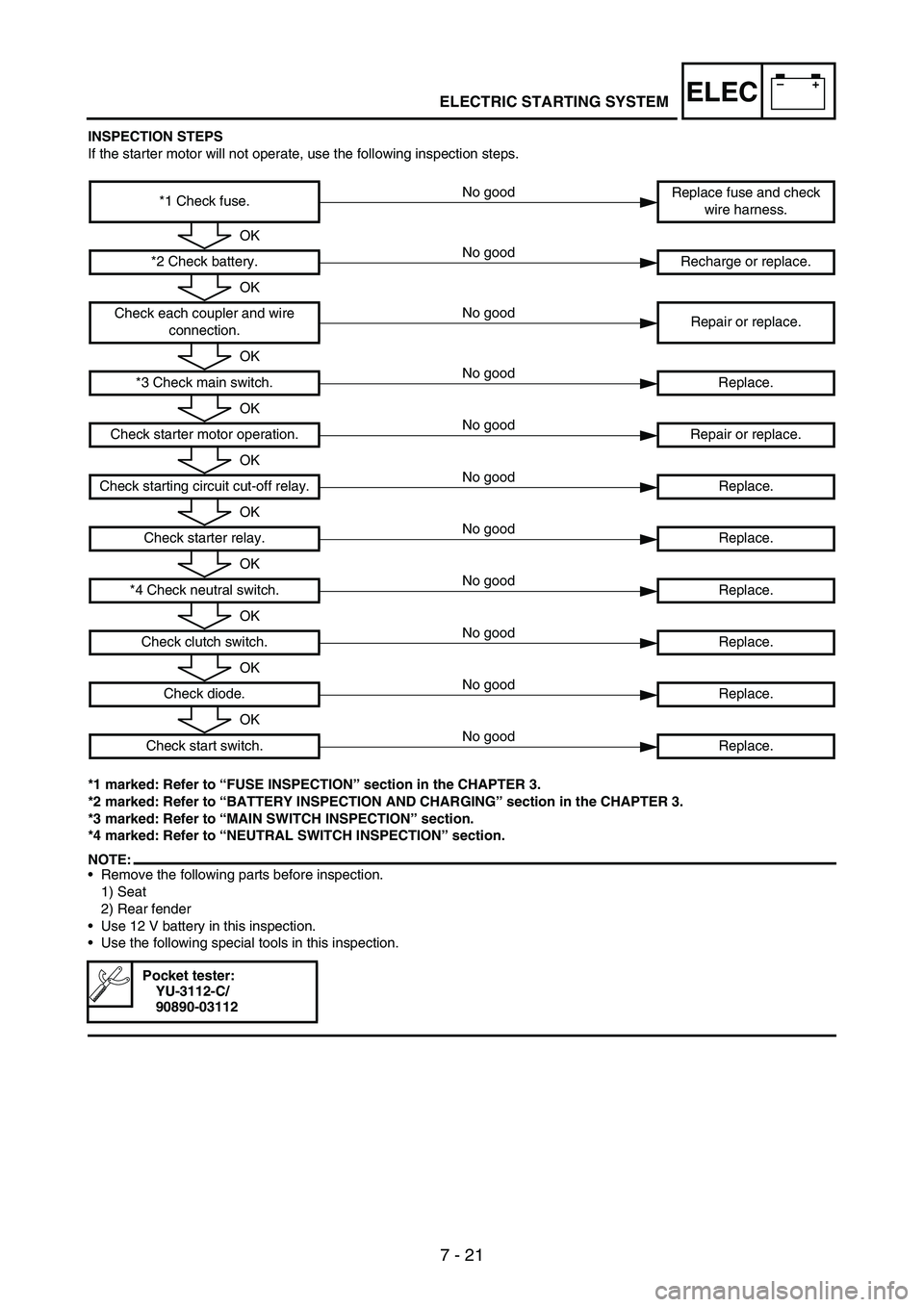
7 - 21
–+ELECELECTRIC STARTING SYSTEM
INSPECTION STEPS
If the starter motor will not operate, use the following inspection steps.
*1 marked: Refer to “FUSE INSPECTION” section in the CHAPTER 3.
*2 marked: Refer to “BATTERY INSPECTION AND CHARGING” section in the CHAPTER 3.
*3 marked: Refer to “MAIN SWITCH INSPECTION” section.
*4 marked: Refer to “NEUTRAL SWITCH INSPECTION” section.
NOTE:•Remove the following parts before inspection.
1) Seat
2) Rear fender
•Use 12 V battery in this inspection.
•Use the following special tools in this inspection.
*1 Check fuse.Replace fuse and check
wire harness.
*2 Check battery. Recharge or replace.
Check each coupler and wire
connection.Repair or replace.
*3 Check main switch. Replace.
Check starter motor operation. Repair or replace.
Check starting circuit cut-off relay. Replace.
Check starter relay.Replace.
*4 Check neutral switch. Replace.
Check clutch switch.Replace.
Check diode.Replace.
Check start switch.Replace.
Pocket tester:
YU-3112-C/
90890-03112
No good
OK
No good
OK
No good
OK
No good
OK
No good
OK
No good
OK
No good
OK
No good
OK
No good
OK
No good
OK
No good
Page 848 of 912
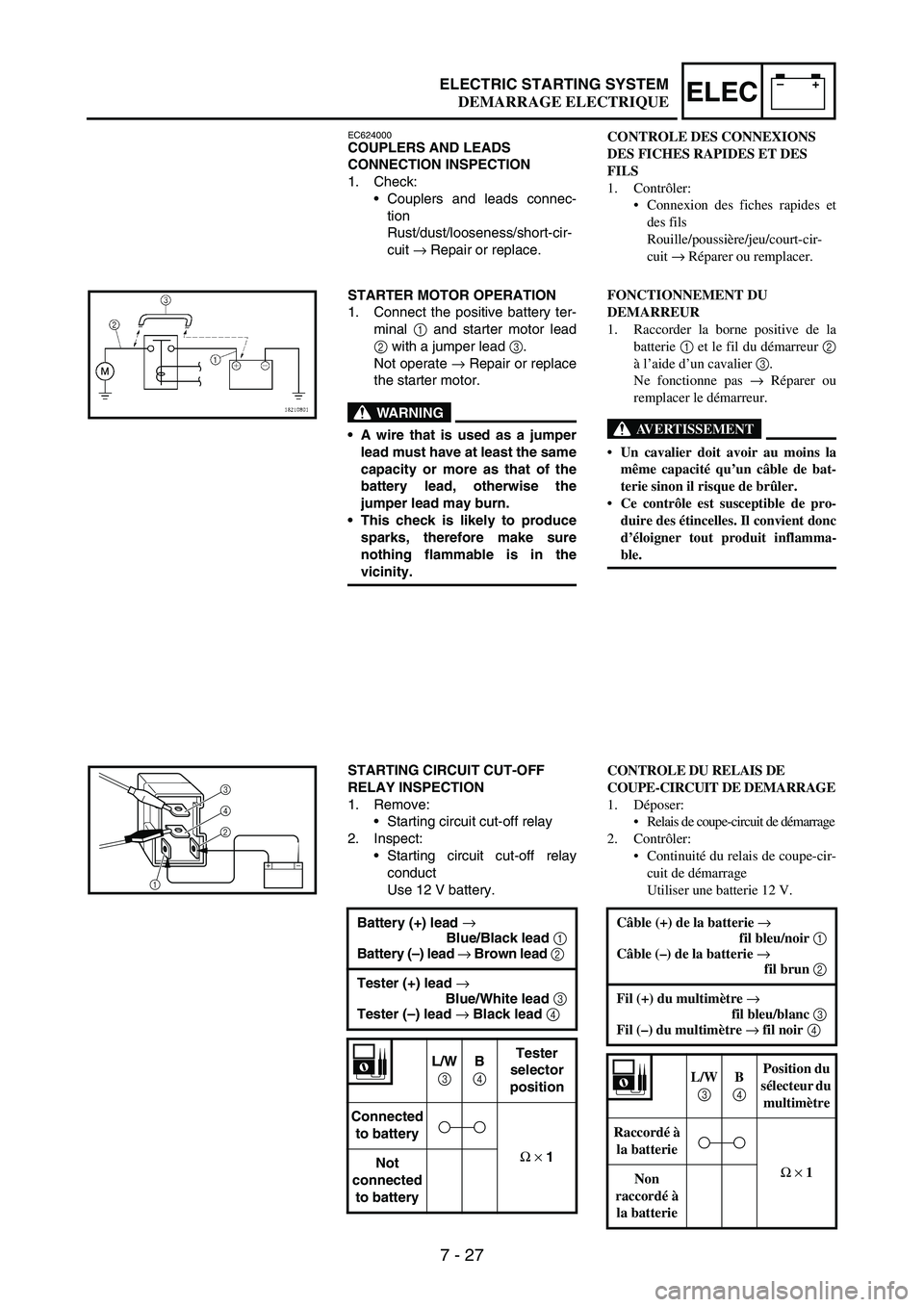
7 - 27
–+ELECELECTRIC STARTING SYSTEM
EC624000COUPLERS AND LEADS
CONNECTION INSPECTION
1. Check:
•Couplers and leads connec-
tion
Rust/dust/looseness/short-cir-
cuit
→ Repair or replace.
STARTER MOTOR OPERATION
1. Connect the positive battery ter-
minal
1 and starter motor lead
2 with a jumper lead
3.
Not operate
→ Repair or replace
the starter motor.
WARNING
A wire that is used as a jumper
lead must have at least the same
capacity or more as that of the
battery lead, otherwise the
jumper lead may burn.
This check is likely to produce
sparks, therefore make sure
nothing flammable is in the
vicinity.
STARTING CIRCUIT CUT-OFF
RELAY INSPECTION
1. Remove:
•Starting circuit cut-off relay
2. Inspect:
•Starting circuit cut-off relay
conduct
Use 12 V battery.
Battery (+) lead →
Blue/Black lead 1
Battery (–) lead →
Brown lead 2
Tester (+) lead →
Blue/White lead 3
Tester (–) lead →
Black lead 4
L/W
3
B
4
Tester
selector
position
Connected
to battery
Ω
×
1
Not
connected
to battery
2 4
3
1
CONTROLE DES CONNEXIONS
DES FICHES RAPIDES ET DES
FILS
1. Contrôler:
Connexion des fiches rapides et
des fils
Rouille/poussière/jeu/court-cir-
cuit → Réparer ou remplacer.
FONCTIONNEMENT DU
DEMARREUR
1. Raccorder la borne positive de la
batterie 1 et le fil du démarreur 2
à l’aide d’un cavalier 3.
Ne fonctionne pas → Réparer ou
remplacer le démarreur.
AVERTISSEMENT
Un cavalier doit avoir au moins la
même capacité qu’un câble de bat-
terie sinon il risque de brûler.
Ce contrôle est susceptible de pro-
duire des étincelles. Il convient donc
d’éloigner tout produit inflamma-
ble.
CONTROLE DU RELAIS DE
COUPE-CIRCUIT DE DEMARRAGE
1. Déposer:
Relais de coupe-circuit de démarrage
2. Contrôler:
Continuité du relais de coupe-cir-
cuit de démarrage
Utiliser une batterie 12 V.
Câble (+) de la batterie →
fil bleu/noir 1
Câble (–) de la batterie →
fil brun 2
Fil (+) du multimètre →
fil bleu/blanc 3
Fil (–) du multimètre → fil noir 4
L/W
3 B
4 Position du
sélecteur du
multimètre
Raccordé à
la batterie
Ω × 1
Non
raccordé à
la batterie
DEMARRAGE ELECTRIQUE
Page 850 of 912
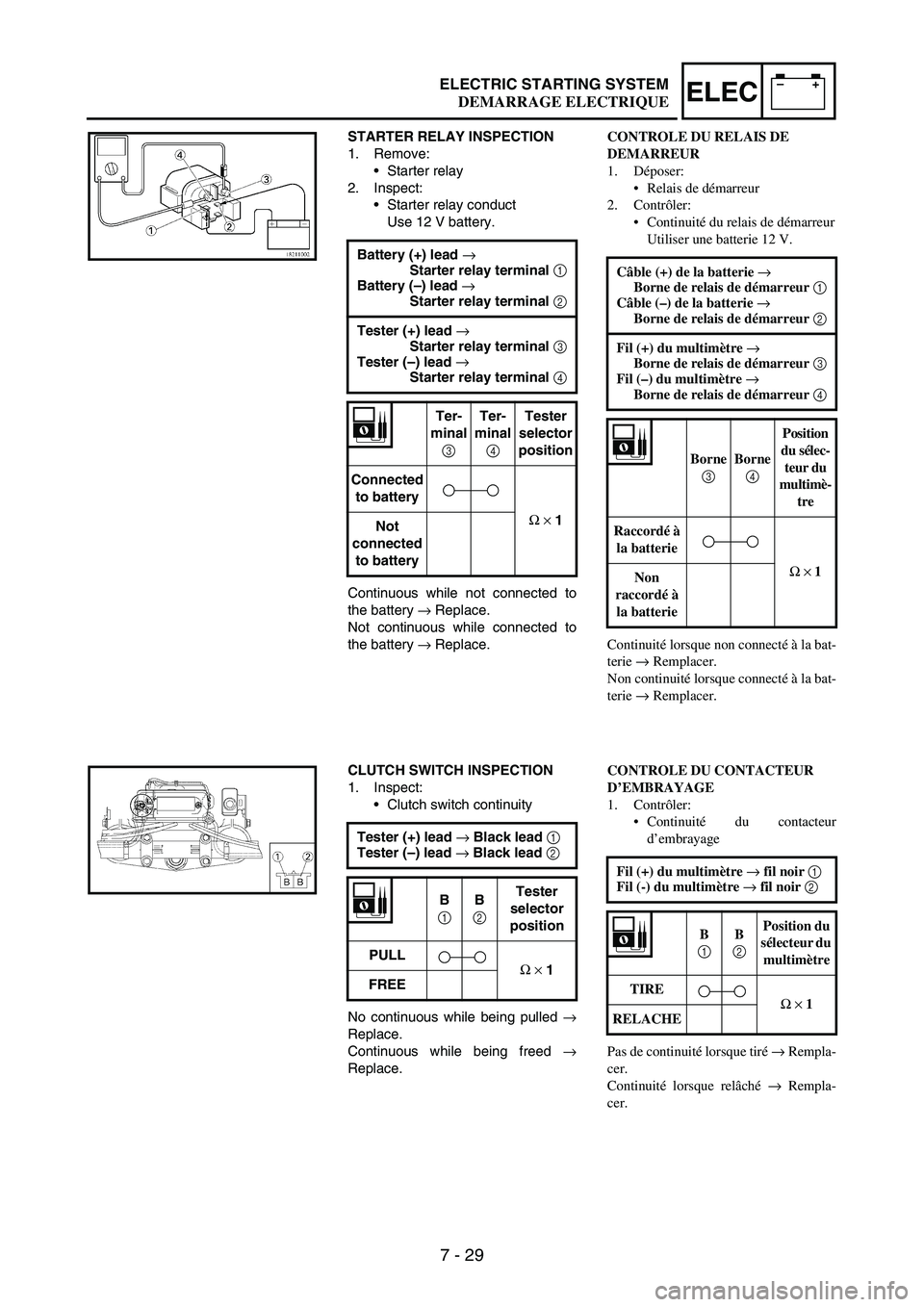
7 - 29
–+ELECELECTRIC STARTING SYSTEM
STARTER RELAY INSPECTION
1. Remove:
•Starter relay
2. Inspect:
•Starter relay conduct
Use 12 V battery.
Continuous while not connected to
the battery
→ Replace.
Not continuous while connected to
the battery
→ Replace. Battery (+) lead →
Starter relay terminal 1
Battery (–) lead →
Starter relay terminal 2
Tester (+) lead →
Starter relay terminal 3
Tester (–) lead →
Starter relay terminal 4
Ter-
minal
3
Ter-
minal
4
Tester
selector
position
Connected
to battery
Ω
×
1
Not
connected
to battery
CLUTCH SWITCH INSPECTION
1. Inspect:
•Clutch switch continuity
No continuous while being pulled
→
Replace.
Continuous while being freed
→
Replace.Tester (+) lead →
Black lead 1
Tester (–) lead →
Black lead 2
B
1
B
2
Tester
selector
position
PULL
Ω
×
1
FREE
CONTROLE DU RELAIS DE
DEMARREUR
1. Déposer:
Relais de démarreur
2. Contrôler:
Continuité du relais de démarreur
Utiliser une batterie 12 V.
Continuité lorsque non connecté à la bat-
terie → Remplacer.
Non continuité lorsque connecté à la bat-
terie → Remplacer. Câble (+) de la batterie →
Borne de relais de démarreur 1
Câble (–) de la batterie →
Borne de relais de démarreur 2
Fil (+) du multimètre →
Borne de relais de démarreur 3
Fil (–) du multimètre →
Borne de relais de démarreur 4
Borne
3 Borne
4 Position
du sélec-
teur du
multimè-
tre
Raccordé à
la batterie
Ω × 1
Non
raccordé à
la batterie
CONTROLE DU CONTACTEUR
D’EMBRAYAGE
1. Contrôler:
Continuité du contacteur
d’embrayage
Pas de continuité lorsque tiré → Rempla-
cer.
Continuité lorsque relâché → Rempla-
cer.Fil (+) du multimètre → fil noir 1
Fil (-) du multimètre → fil noir 2
B
1 B
2 Position du
sélecteur du
multimètre
TIRE
Ω × 1
RELACHE
DEMARRAGE ELECTRIQUE